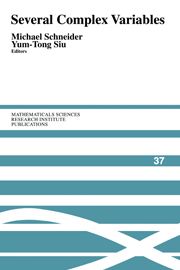Book contents
- Frontmatter
- Contents
- Preface
- Local Holomorphic Equivalence of Real Analytic Submanifolds in ℂN
- How to Use the Cycle Space in Complex Geometry
- Resolution of Singularities
- Global Regularity of the ∂-Neumann Problem: A Survey of the L2-Sobolev Theory
- Recent Developments in the Classification Theory of Compact Kahler Manifolds
- Remarks on Global Irregularity in the ∂-Neumann Problem
- Subelliptic Estimates and Finite Type
- Pseudoconvex-Concave Duality and Regularization of Currents
- Complex Dynamics in Higher Dimension
- Attractors in ℙ2
- Analytic Hilbert Quotients
- Varieties of Minimal Rational Tangents on Uniruled Projective Manifolds
- Recent Developments in Seiberg-Witten Theory and Complex Geometry
- Recent Techniques in Hyperbolicity Problems
- Rigidity Theorems in Kahler Geometry and Fundamental Groups of Varieties
- Nevanlinna Theory and Diophantine Approximation
Rigidity Theorems in Kahler Geometry and Fundamental Groups of Varieties
Published online by Cambridge University Press: 25 June 2025
- Frontmatter
- Contents
- Preface
- Local Holomorphic Equivalence of Real Analytic Submanifolds in ℂN
- How to Use the Cycle Space in Complex Geometry
- Resolution of Singularities
- Global Regularity of the ∂-Neumann Problem: A Survey of the L2-Sobolev Theory
- Recent Developments in the Classification Theory of Compact Kahler Manifolds
- Remarks on Global Irregularity in the ∂-Neumann Problem
- Subelliptic Estimates and Finite Type
- Pseudoconvex-Concave Duality and Regularization of Currents
- Complex Dynamics in Higher Dimension
- Attractors in ℙ2
- Analytic Hilbert Quotients
- Varieties of Minimal Rational Tangents on Uniruled Projective Manifolds
- Recent Developments in Seiberg-Witten Theory and Complex Geometry
- Recent Techniques in Hyperbolicity Problems
- Rigidity Theorems in Kahler Geometry and Fundamental Groups of Varieties
- Nevanlinna Theory and Diophantine Approximation
Summary
We review some developments in rigidity theory of compact Kahler manifolds and related developments on restrictions on their possible fundamental groups.
1. Introduction
This article surveys some developments, which started almost twenty years ago, on the applications of harmonic mappings to the study of topology and geometry of Kahler manifolds. The starting point of these developments was the strong rigidity theorem of Siu [1980], which is a generalization of a special case of the strong rigidity theorem of Mostow [1973] for locally symmetric manifolds. Siu's theorem introduced for the first time an effective way of using, in a broad way, the theory of harmonic mappings to study mappings between manifolds. Many interesting applications of harmonic mappings to the study of mappings of Kahler manifolds to nonpositively curved spaces have been developed since then by various authors. More generally the linear representations (and other representations) of their fundamental groups have also been studied. Our purpose here is to give a general survey of this work. One interesting by-product of this study is that it has produced new results on an old an challenging question: what groups can be fundamental groups of smooth projective varieties (or of compact Kahler manifolds)? These groups are called Kahler groups for short, and have been intensively studied in the last decade. New restrictions on Kahler groups have been obtained by these techniques. On the other hand new examples of Kahler groups have also shown the limitations of some of these methods. We do not discuss these developments in much detail because we have nothing to add to the recent book [Amoros et al. 1996] on this subject.
Information
- Type
- Chapter
- Information
- Several Complex Variables , pp. 509 - 534Publisher: Cambridge University PressPrint publication year: 2000
